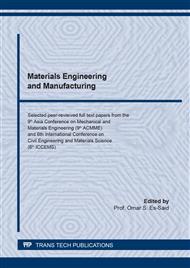p.62
p.68
p.74
p.85
p.90
p.97
p.103
p.111
p.120
Characterization and Hydrogen Storage Capacity Analysis of Dip Coated Lithium Aluminium Hydride Thin Films
Abstract:
Complex metal hydrides are one of the most effective hydrogen storage materials due to their unique property to absorb and desorb hydrogen with the hydrogen storage capacity of about 5-7 wt%. In this study, lithium aluminium hydride (LiAlH4) was coated on glass substrate using dip coating method. The coating conditions investigated were LiAlH4 concentrations of 6 g/l, 10 g/l and 20 g/l and post-annealing time from 0 to 60 min. Phase and grain size of the deposited LiAlH4 were analyzed using X-ray powder diffraction (XRD). Scanning electron microscope (SEM) was used for surface morphology analysis. The hydrogen storage capacity of the deposited thin films was analyzed using thermogravimetric analysis (TGA). The experimental results revealed that the phase of the deposited LiAlH4 thin films on glass substrate were mixed with lithium aluminium hydroxide hydrate (LiAl2(OH)7·2H2O) and lithium hexahydroaluminate (Li3AlH6). The intensity of the LiAl2(OH)7·2H2O and LiAlH4 peaks tends to decrease with increasing LiAlH4 concentration and post-annealing time while the intensity of the Li3AlH6 peaks increased with increasing LiAlH4 concentration and post-annealing time. The grain size was decreased with increasing LiAlH4 concentration and post-annealing time. The smaller grain size the better the hydrogen storage capacity. The hydrogen storage capacity of the deposited LiAlH4 thin film was increased from 0.124 wt % using LiAlH4 concentration of 6 g/l without post-annealing to 1.675 wt % using LiAlH4 concentration of 20 g/l with 60 min post-annealing time.
Info:
Periodical:
Pages:
90-96
Citation:
Online since:
October 2021
Keywords:
Price:
Сopyright:
© 2021 Trans Tech Publications Ltd. All Rights Reserved
Share:
Citation:


